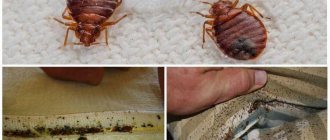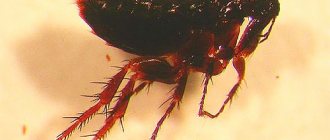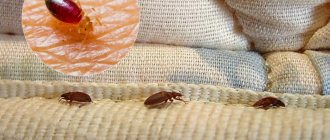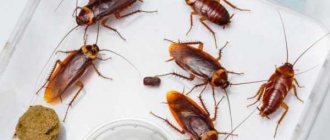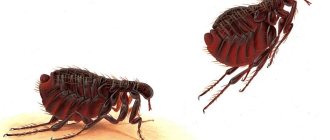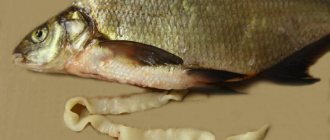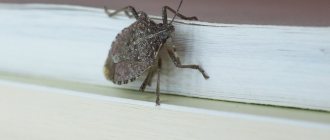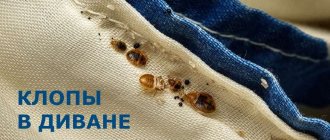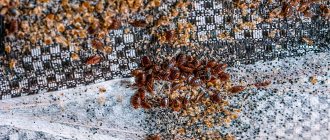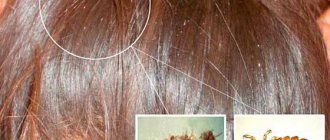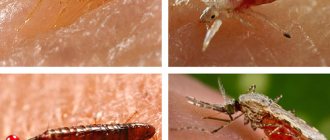When a person for the first time in his life encounters certain insects found in the sofa, it is very difficult for him to immediately determine who they are, what kind of unpleasant “guests” have settled in his upholstered furniture. It is for this reason that we want to give you descriptions of several bugs and smaller insects that are more likely to take up residence in sofas. There is no need to be afraid right away, even though the phenomenon is extremely unpleasant, but it is better to listen to some recommendations from specialists who will help get rid of such “settlers” in the shortest possible time.
Determining who it could be
So, let's get to know the most active residents of sofa upholstery, inside a niche or between ottomans.
Carpet beetle in upholstered furniture
There are different types of carpet beetles; there are 4 variants of the most common varieties that could live in sofas:
- Carpet beetles with a 2-4 mm body of a rich brown uniform color . Feature: adult individuals feed on the subcutaneous “fat” that they accumulated in the larval stage, and the larvae themselves eat carpets.
- Ham . They have body sizes of up to 7-9.5 mm and are two-colored – yellowish-gray and brown . Feature: the beetle reproduces too quickly.
- Fur coats . Little black bugs with a body length of 4-6 mm, on the backs of which there are always 5 white dots . Feature: they love to live in sofas with fur upholstery.
- House or museum . The length of the bodies of such beetles reaches 5-6 mm on average, they are brown and like to live not only in sofas, but also in flower pots , thereby damaging plants. Feature: you rarely see them in a house or apartment, but their appearance cannot be ruled out.
It should be noted that if the bug does not feed on sofa fabrics or leather upholstery, then it may well simply live there, feeding on something else. This beetle usually feeds:
- cardboard;
- fibers from old fabrics;
- old loose wood;
- glue;
- carpets;
- cat or dog hair;
- food products - cereals, for example, or bread crumbs;
- and, of course, skin.
- Frequent vacuuming . Use a vacuum cleaner twice a day in areas where beetles are found. And do this for a week or 10 days.
- Spray the sofa with some insecticide to kill these pests.
- Use different temperatures and sudden changes when cleaning the sofa. Beetles don’t like this very much; they may even die if the room is ventilated sharply for several hours in winter.
- Use a steam generator with a chemical that kills bugs and their larvae.
- Use powders, tablets, traps and other devices as additives.
Let's take a look at a couple of drugs that you can safely use to get rid of skin beetles in your sofa.
Skin beetle:
Checklist for assessing the degree of harmfulness of infection
For larvae of skin beetles of all types, a nutrient medium is vitally needed that would supply them with keratin-containing elements - horny particles, hair, fur and all animals, plant and artificial, the like. In your apartment, pay attention to what can serve as such a source for skin beetles:
- Do you keep stuffed animals or birds at home, or maybe a collection of insects? Consider that a source has been discovered. If there is fur at home, but the leather beetles have not yet reached these things, it is quite possible that the conditions for the beetles are unsuitable, and the eggs develop slowly. This usually happens when the house is cold or damp.
- Do you have a rare collection of tomes, or do you just like to keep books at home? Take care of the safety of their bindings.
- Have you recently bought something special made from materials that the leather beetle happily eats? Find the larvae and all adult beetles as soon as possible and destroy them before they multiply and completely damage new things. Perhaps these materials served as a source of infection.
- Do you have a cat? Is she also long-haired? It may not be easy to remove skin beetles. The fact is that in the apartment where the cat lives, a lot of hair always collects on the floor, it falls out regularly, and therefore it is necessary to remove it from surfaces often, at least every other day. Otherwise, the skin beetle larvae will always be provided with food.
Whatever the reason for the appearance of skin beetles in the apartment, it is important to start getting rid of them as soon as possible.
Vadim Verevkin
Please rate the material
comments powered by HyperComments
Clothes (linen) louse
Body lice (also known as linen or scabies) lice infest in old, unwashed clothes or bedding. They hide in the fabric and then bite a person at night if they are close to him. It is possible that they may well live in sofa upholstery, penetrating deeply into its structure. This is why fogging or spraying with a deep-penetrating insecticide is the most effective way to get rid of these insects. Linen louse activity is observed at night; they are invisible during the day. The body is smooth, ranging in size from 2 to 5 mm, has antennae, and the color of the body changes depending on blood saturation. A hungry louse is light and translucent yellowish , while a well-fed louse has a dark dot on its abdomen.
Fighting methods:
- Boil clothes more often when washing , or wash in a mode where there is hot water in the washing machine. Woolen items should be dried properly to prevent shrinkage.
- add vinegar to the wash , which softens not only the integument of adults, but also nits.
- It will be useful to take the sofa out into the sun or frost.
- Even ironing a sofa with a steaming iron , if it has fabric upholstery, can easily destroy a good part of the lice. Vinegar is also added to the water in the iron.
- Especially when steaming a sofa, you should repeatedly go over the seams of the upholstery , where larvae and lice can get clogged.
- Treat with any preparation that destroys lice. Eg. Karbofos or a composition such as a mixture of kerosene and soap solution.
Bed mite
The insect belongs to the order Arachnida. It is difficult to see it without a microscope. The body length of an adult individual barely reaches 0.5 mm. It looks like a small crab. Bed mites or linen parasites can appear in any room. It will be in feather pillows and feather beds.
Because it feeds on particles of skin, sweat, and dandruff. The insect does not bite; in this sense, there is no harm to humans. But the danger lies in its excrement. They are so small that they easily become airborne and enter the human respiratory tract.
The rest settles on the surface of the skin. As a result, it appears:
- intractable atopic dermatitis;
- sore throat, dry cough, rhinitis without signs of disease;
- headache, weakness;
- increased frequency of asthma attacks.
Preventative measures to prevent insects from infesting the sofa
Any bugs can be kept out of your sofa if you follow the following preventative instructions:
- Regularly carry out wet cleaning with ventilation.
- Beetles do not like light, so you can always open the curtains during the daytime.
- In the sofa, let there be bunches of wormwood, lavender, sachets with caustic herbs, or other remedies for moths or skin beetles.
- It is better to have mosquito nets on the windows to prevent bugs from flying in if they are winged.
- Clean your shoes or pants when you come home from the street and vacuum and wash the hallway more often so as not to bring pests into the house.
- Less storage of junk in the sofa means fewer bugs.
- In a dry and warm “climate”, individuals develop very quickly.
The regular presence of blood-sucking insects in the bed means not only sleep disturbances, nightmares at night and itchy bites in the morning, but also a constant risk of contracting quite dangerous infections. Yes, such that the next day you can be busy all day just getting rid of such bites. For example, some blood-sucking human parasites are potentially capable of transmitting the causative agents of plague, encephalitis (and we are not just talking about ticks), anthrax and typhoid. This alone is enough for you to immediately take measures to remove them at the first suspicion of the presence of “bed” insects in the house.
You shouldn’t expect that living in a big city and a comfortable apartment will guarantee protection from insects in your bed. A characteristic feature of such human parasites is their indifference to the cleanliness and sanitary condition of the room, because they feed on blood, and not on the remains of our food.
Perhaps the most unpleasant blood-sucking insects that you can find in your bed are house bugs. It may seem strange, but they are a real disaster in Amsterdam, London and Stockholm. According to statistics, in most large European cities the number of apartments and houses infested with bedbugs is constantly growing, and disinfestation services cannot always cope with rapidly multiplying parasites that manage to develop resistance to the insecticides used. According to statistics, more than half of the homes in Florida, USA, have also been infested with bedbugs at some time.
When figuring out what insects bite you in bed, the easiest way will be to catch the parasite right at the scene of the crime, carefully examine it and compare it with the photographs below. Below are photos of the most common “bed” insects, in which you can recognize your offenders.
Bed bugs - their length, depending on age and degree of saturation, usually varies from 2-3 to 8 mm. The photo below shows this using an example of an adult bedbug:
This is what a bedbug larva looks like:
Fleas usually bite in the morning. They jump very well, and if you can’t catch an insect in the bed, perhaps it’s them.
The photo shows a flea on a human body at the time of the bite:
Linen lice are insects that are not even attached to the bed, but more to the human body. They bite around the clock, but at night their activity is especially noticeable.
Photo of an adult louse:
And this is what nits look like - lice eggs in a dense shell:
And, of course, mosquitoes - everyone knows them, so there will be no problems with their identification:
Some of these insects can be identified by the appearance of their bites, but the most reliable way to see the parasite itself is to see it in person.
Generally speaking, the insects that can be found on the sofa or in the bed include domestic cockroaches, but such cases are quite rare. Meanwhile, even ordinary red cockroaches, with a lack of water, can eat away the epithelium around the lips of sleeping people, especially children. This is exactly the case when we can say that even cockroaches bite.
So, if you have already managed to recognize which insects bite in bed, it’s time to get to know these parasites in detail to find out how you can fight them...
A little about bedbugs: photos, behavioral features, lifestyle
Bed bugs are perhaps the largest blood-sucking parasites of humans, and to this day they are quite often found in apartments. The photo below shows several of these insects on the bed (usually this picture can be seen at night when the light is suddenly turned on):
And in the next photo there is a nest of bedbugs in the sofa. These insects prefer to hide as close as possible to human resting places:
“This is some kind of nightmare. Never in our life have we had any insects in our apartment, but then we began to discover that in the morning some kind of bites appeared on our bodies. We started to find out and once caught a bug at night. Such a disgusting creature, still fat, it’s clear that he’s pumped up some blood. I was hysterical, I went to live with a friend, and my husband called some services to poison everything. Now they don’t seem to be there, but I still check myself in the morning.”
Dry cleaning of sofas as a means of getting rid of pathogens
The possibility of the appearance and reproduction of bedbugs and mites is not the only potential nuisance for furniture owners. In addition, the likelihood of the above-mentioned events occurring becomes high only if hygiene rules are not followed. At the same time, there is a more pressing danger. We are talking about accumulations of bacteria and microbes that can cause irritation and allergies even in the most resistant people.
To prevent unfavorable developments, it is advisable to dry clean the sofa once every 3-4 months. With this approach, you don’t have to worry about the harmful effects of microorganisms and look for information on how to get rid of parasites in the sofa. No bacteria - no problem.
Bedbug bites and their consequences
Bedbug bites appear as red spots on the skin with a characteristic point where the insect inserted its proboscis. Often the bug leaves a whole chain of 3-7 such bites, piercing the skin in several places. It is by such chains (paths) that these insects, which often live directly in beds, are easily recognized.
If there are a large number of bed bugs in the house and high sensitivity to their bites, a person under attack may develop an allergic reaction with profuse rashes on the skin and generalized symptoms. Children with heavy and regular bedbug bites may even develop anemia. In addition, constant itching from bites does not allow the victim to feel normal, and when scratching the wounds, pustular inflammation can develop.
Bed bugs are potential carriers of many infections, but doctors have not recorded cases of transmission of diseases such as HIV or hepatitis.
Preventive measures
It is not possible to completely protect your home from pests. But there are options that help worsen their living conditions and reduce the likelihood of their reproduction. The main thing may be the choice of special sockets and timely cosmetic repairs. Here is another list of actions:
- Turn the mattress over frequently and check it for any signs of insects.
- Try not to bring them into the house or carefully inspect them.
- Wear shoe covers in places where bedbugs are likely to spread.
- Don't take other people's furniture off the street.
- Inspect the wallpaper on the walls; there should be no defects on them. In the future, bloodsuckers can move into such places.
- Do not lay parquet on floors.
- Make sure you don't bring bedbugs from school or the street.
How to deal with bedbugs
There are two reliable ways to remove bedbugs:
- Poisoning them with special insecticidal sprays or aerosols. The first include, for example, concentrates for dilution Delta Zone, Lambda Zone, Get, Karbofos, Executioner, Sinuzan. The second includes ready-to-use products in aerosol cans: Raptor, Dichlorvos, Combat and their analogues. Sprays are more effective, especially if there are a large number of bloodsuckers in the house, but are somewhat more difficult to use.
- The second option is to call special pest control teams that poison bedbugs often with the same insecticides, but relieve the apartment resident from the risk of poisoning himself.
Removing bedbugs yourself is cheaper, but requires a serious investment of time and effort. When contacting pest control services, you need to be careful so as not to encounter scammers or those who, in fact, do not do the work.
In the photo there is a nest of bedbugs in furniture:
If these insects are infested in a sofa or other furniture, they can be frozen out outside in winter at temperatures below minus 20°C. However, this method is rarely effective, since bedbugs often hide not only in the sofa, but also in other places in the apartment.
You can also kill bedbugs in an apartment with heat, raising the room temperature to +50°C, which is usually achieved using industrial fan heaters. Of course, such a procedure must be carried out very carefully and with all precautions.
Fleas: when they bite and how to deal with them
A flea is a small jumping blood-sucking insect that attacks mainly during daylight hours. Not everyone thinks about it, but fleas can potentially carry plague, anthrax, typhoid, encephalitis, brucellosis and many other serious diseases, so you should be especially careful about protecting yourself from these parasites.
It was fleas and their hosts, rats, that became the cause of the extensive bubonic plague pandemic in the Middle Ages, during which almost a third of the European population died out.
Flea bites are quite similar to bedbug bites and can also form characteristic tracks, only short ones.
The photo shows a flea on human skin:
These insects are clearly visible on white bedding, but it can be quite difficult to catch them: they jump so quickly that the jump itself is not noticeable at all.
Fleas need to be removed in two stages: first, they are poisoned from pets, and then from the entire apartment.
Sometimes fleas have to be poisoned again if the infestation of the premises is especially high.
When baiting fleas in an apartment, the same drugs are used as against bedbugs. But to remove fleas from cats and dogs, you need to use completely different means, more gentle and safe, with reduced concentrations of insecticides.
Harm
Anthrenuses and leather beetles damage food, things, furniture, fabrics (not only wool), leather goods, books, and carpets. Insects chew through drywall, wooden furniture, even electrical wiring. Omnivorous insects live not only in the kitchen: pests crawl throughout the apartment.
Small brown beetles carry dangerous disease pathogens on their tiny legs and antennae. Insects move through dusty corners, food waste, the bathroom area, move into the kitchen, and crawl on food. It is difficult to talk about maintaining hygiene standards after such “travels”.
Lice: the parasites that are always around
Lice in bed are quite rare. For these insects, falling from the hair or body of a person is fatal - they are slow and rarely able to climb back (at the same time, they vitally need to feed on blood very often). Lice cannot be called typical bed blood-sucking insects.
Lice spend their entire lives on the head (head lice) or other hairy parts of a person (pubic lice). There are also linen lice that live in clothes, but today they are found only among tramps who very rarely change their clothes and never wash them.
Lice bites are usually less noticeable and less painful than flea or bedbug bites, but because they are so numerous, they can also be quite itchy.
The photo shows nits in a child’s hair (lice eggs):
Lice should be removed with special pediculicidal shampoos or sprays. Special thick combs for combing parasites out of hair also work well against them.
Do cockroaches bite at night?
Cockroaches rarely bite humans. They are inhabitants of kitchens, feeding on crumbs from the table and leftover food in trash cans. Only with very abundant reproduction and a lack of water can they crawl onto the bed and gnaw the epidermis around the lips and nose of people. Today, similar situations sometimes occur in hostels.
Of course, cockroaches are not blood-sucking insects, so even if they bite, it’s completely different from the way fleas or bed bugs do.
In any case, if you are bitten by insects, their bites should be treated to reduce itching and prevent infection:
- bite sites are washed with soapy water
- the most painful bites are wiped with alcohol or alcohol tincture of calendula or propolis
- Itching from bites can be reduced with Fenistil gel.
But if, after being bitten by blood-sucking insects, the temperature begins to rise and a characteristic rash appears on the skin, it is advisable to show the person to a doctor. An allergy to bites can have serious consequences, and even if at a particular moment it does not manifest itself very strongly, in the future the reaction to bites can be extremely acute.
The most modern, stylish apartment is not protected from insects. Small crawling, flying individuals do not pay attention to the degree of grooming or the design of the home. Penetrating in different ways, they can cause a lot of problems for the owner, especially if they choose a sofa as their habitat. In this article, we suggest finding out what can grow in upholstered furniture, and we will also tell you about the ways that insects can enter the apartment.
Where do insects come from on the sofa?
Any living creature seen on your living space is incoming or brought. They do not appear by themselves. Therefore, you don’t have to worry about old furniture or excess hair from a pet. On the contrary, a new sofa brought from a warehouse may be infected. So, the main ways insects appear in upholstered furniture are:
- Purchase of an initially infected sofa. This can be either new or used furniture. To protect yourself, be sure to inspect the upholstery, niches, and cracks of the sofa before unloading. If you notice any larvae, black spots, odors that are not specific to furniture, or single bugs, do not bring such furniture into the house under any circumstances.
- Transfer of insects from neighbors through communications. Mass infection of a neighboring apartment, a single treatment with strong chemicals, can lead to the migration of individuals into the adjacent room and the furniture in it.
- Infection with new things thrown on the sofa. Any new item (clothes, parcels, wooden souvenirs) should not be left on the sofa. Before use, you need to conduct a thorough inspection (after all, in postal and other warehouses there are often bedbugs and beetles), wash, wash, and only then allow it to be used.
- Returning home after business trips or hospital stay. Insects brought on things from public places can quickly spread throughout the apartment and settle in the sofa. To prevent this from happening, immediately upon arrival, disassemble and wash things at high temperatures.
Why do bugs choose upholstered furniture?
We found out where insects can get into a home sofa, but why do they choose upholstered furniture? There are several reasons for this. Firstly, it is easier to hide in cracks and folds of upholstery and build a nest. Secondly, many pests prefer dry, untreated wood, which is easier to move on than on smooth surfaces. They also settle closer to food. Food, in different situations, is the person himself, or waste products: exfoliated cells, hair. Since rest mainly takes place on the sofa, there is the most dead epithelium on it.
Some types of insects, such as bedbugs, settle in the sofa in order to bite and drink human blood at night. Living in close proximity, they find the victim by smell and crawl out at night when the person is fast asleep and does not move.
Important Tips
If the sofa has to be processed, then increased attention must be paid to the seams of the upholstery and the joints of individual furniture parts. It is there that parasites of all the above species prefer to settle and lay eggs.
When choosing factory-produced chemicals, it is better to choose highly specialized preparations intended to kill a specific type of insect. Widely advertised universal formulations either have extremely high toxicity or demonstrate low effectiveness against large populations of pests that have long settled in the sofa and managed to multiply.
It is advisable to repeat any selected treatment procedures two weeks after the first disinfestation session, since this is approximately the time for the next generation of parasites to hatch from the surviving eggs. After re-processing the furniture and premises, the problem with uninvited guests will be completely resolved.
What types of insects can live in a home sofa?
Cozy, beloved upholstered furniture can become a temporary shelter for several types of insects:
- Fleas. Small, black, jumping dots that bite painfully. They appear not only in rooms with pets. They can drop into any apartment and be carried in on outer clothing, especially if homeless animals often wander around the entrance. This is also a common problem for residents of the first floors; fleas multiply in the basement and jump to nearby dwellings.
- Bedbugs. They look a little like cockroaches, but have a more rounded shape. They hide in the cracks of the sofa, and at night crawl out to snack on human blood. They can be identified by bites on the body, traces of vital activity on bed linen: black spots of excrement, blood stains from individuals crushed in sleep, brown dry scales that bedbugs shed as they grow.
- Carpet beetles. They do not bite a person directly, but they can start in a sofa that is rarely cleaned. They readily eat crumbs, particles of dead epithelium of humans and animals, fibers of old fabrics, and natural leather upholstery untreated with protective agents. They can get into the apartment through open windows that are not protected by mosquito nets, or fly into bags and packages on the street. They are dangerous for both leather and fabric sofas, because they devour everything.
- Linen lice. They can start in sofa upholstery, which consists of natural fibers, mattresses, and bed linen. Lice are invisible during the day, but at night they actively bite sleeping people. Most often they appear upon contact with contaminated things or people. Therefore, you should not put someone else’s clothes on your home sofa, or seat an unfamiliar, unkempt person on it.
Now you know which insects live in the sofa, which can bite, and which can damage the upholstery. In any case, such a neighborhood is dangerous for human health; if you find at least one individual, it is better to immediately sanitize the furniture. Even a new sofa is not a guarantee of the absence of insects, especially if it is of an unknown manufacturer. Check any furniture before bringing it into the house, and if you want to protect yourself one hundred percent, choose sofas from Dommino
